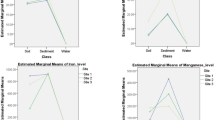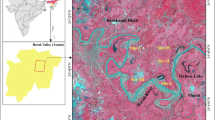Abstract
Arsenic (As) is a widespread environmental and food chain contaminant and class I, non-threshold carcinogen. Plants accumulate As due to ionic mimicry that is of importance as a measure of phytoremediation but of concern due to the use of plants in alternative medicine. The present study investigated As accumulation in native plants including some medicinal plants, from three districts [Chinsurah (Hoogly), Porbosthali (Bardhman), and Birnagar (Nadia)] of West Bengal, India, having a history of As pollution. A site-specific response was observed for Specific Arsenic Uptake (SAU; mg kg − 1 dw) in total number of 13 (8 aquatic and 5 terrestrial) collected plants. SAU was higher in aquatic plants (5–60 mg kg − 1 dw) than in terrestrial species (4–19 mg kg − 1 dw). The level of As was lower in medicinal plants (MPs) than in non-medicinal plants, however it was still beyond the WHO permissible limit (1 mg kg − 1 dw). The concentration of other elements (Cu, Zn, Se, and Pb) was found to be within prescribed limits in medicinal plants (MP). Among the aquatic plants, Marsilea showed the highest SAU (avg. 45 mg kg − 1 dw), however, transfer factor (TF) of As was the maximum in Centella asiatica (MP, avg. 1). Among the terrestrial plants, the maximum SAU and TF were demonstrated by Alternanthera ficoidea (avg. 15) and Phyllanthus amarus (MP, avg. 1.27), respectively. In conclusion, the direct use of MP or their by products for humans should not be practiced without proper regulation. In other way, one fern species (Marsilea) and some aquatic plants (Eichhornia crassipes and Cyperus difformis) might be suitable candidates for As phytoremediation of paddy fields.
Similar content being viewed by others
References
Abedin, M. J., Cresser, M., Meharg, A. A., Feldmann, J., & Cotter-Howells, J. (2002). Arsenic accumulation and metabolism in rice (Oryza sativa L.). Environmental Science Technology, 36, 962–968.
Annan, K., Kojo, A. I., Cindy, A., Samuel, A. N., & Tunkumgnen, B. M. (2010). Profile of heavy metals in some medicinal plants from Ghana commonly used as components of herbal formulations. Pharmacology Research, 2, 41–44.
Baye, H., & Hymete, A. (2010). Lead and cadmium accumulation in medicinal plants collected from environmentally different sites. Bulletin of Environmental Contamination and Toxicology, 84, 197–201.
Caldas, E. D., & Machado, L. L. (2004). Cadmium, mercury and lead in medicinal herbs in Brazil. Food and Chemical Toxicology, 42, 599–603.
Carter, M. R., & Gregorich, E. G. (2007). Soil sampling and methods of analysis (2nd ed., p. 264). London: CRC Press.
Duthie, J. F. (1960). Flora of the upper Gangetic plain and of adjacent Siwalik and Sub-Himalayan tracts (Vol. I and II). Calcutta: Gouranya.
Dwivedi, S., Srivastava, S., Mishra, S., Dixit, B., Kumar, A., & Tripathi, R. D. (2008). Screening of native plants and algae growing on fly-ash affected areas near National Thermal Power Corporation, Tanda, Uttar Pradesh, India for accumulation of toxic heavy metals. Journal of Hazardous material, 158, 359–365.
Dwivedi, S., Srivastava, S., Mishra, S., Kumar, A., Tripathi, R. D., Rai, U. N., et al. (2010a). Characterization of native microalgal strains for their chromium bioaccumulation potential: Phytoplankton response in polluted habitats. Journal of Hazardous material, 173, 95–101.
Dwivedi, S., Tripathi, R. D., Srivastava, S., Singh, R., Kumar, A., Tripathi, P., et al. (2010b). Arsenic affects mineral nutrients in grains of various Indian rice (Oryza sativa L.) genotypes grown under arsenic-contaminated soils of West Bengal. Protoplasma, 245, 113–124.
Fitz, W. J., & Wenzel, W. W. (2002). Arsenic transformations in the soil–rhizosphere–plant system: Fundamentals and potential application to phytoremediation. Journal of Biotechnology, 99, 259–278.
Francesconi, K., Visootiviseth, P., Sridokchan, W., & Goesiler, W. (2002). Arsenic species in an arsenic hyperaccumulating fern, Pityrogramma calomelanos: Potential phytoremediator of arsenic contaminated soil. The Science of Total Environment, 284, 27–35.
Gasser, U., Klier, B., Kutin, A. V., & Steinhoff, B. (2009). Current findings on the heavy metal content in herbal drugs. Pharmeuopa Science Notes. 1, 37–50.
Gomez, K. A., & Gomez, A. A. (1984). Statistical procedures for agricultural research. New York: John.
Han, X. M., Wang, R. Q., Liu, R., Wang, M. C., Zhou, J., & Guo, W. H. (2007). Effects of vegetation type on soil microbial community structure and catabolic diversity assessed by polyphasic methods in North China. Journal of Environmental Science China, 19, 1228–1234.
Indriolo, E., Na, G., Ellis, D., Salt, D. E., & Banks, J. A. (2010). A vacuolar arsenite transporter necessary for arsenic tolerance in the arsenic hyperaccumulating fern Pteris vittata. The Plant Cell, 22, 2045–2057.
Iwalewa, E. O., Iwalewa, O. J., & Adeboye, J. O. (2003). Analgesic, antipyretic, anti-inflammatory effects of methanol, chloroform and ether extracts of Vernonia cinerea less leaf. Journal of Ethnopharmacology, 86, 229–234.
Khan, S. A., Khan, A., Hussain, I., Marwat, K. B., & Akhtar, N. (2008). Profile of heavy metals in selected medicinal plants. Pak Journal of Weed Science Research, 14, 101–110.
Kirk, G. (2004). The biochemistry of submerged soils. Hoboken: Wiley.
Lee, C. D., Ott, M., Thyagarajan, S. P., Shafritz, D. A., Burk, R. D., & Gupta, S. (1996). Phyllanthus amarus down-regulates hepatitis B virus mRNA transcription and replication. European Journal of Clinical Investigation, 26, 1069.
Lu, Y., Adomako, E. E., Solaiman, A. R. M., Islam, M. R., Deacon, C., Williams P. N., et al. (2009). Baseline soil variation is a major factor in arsenic accumulation in Bengal delta paddy rice. Environmental Science Technology, 43, 1724–1729.
Lu, Y., Dong, F., Deacon, C., Chen, H. J., Raab, A., & Meharg, A. A. (2010). Arsenic accumulation and phosphorus status in two rice (Oryza sativa L.) cultivars surveyed from fields in South China. Environmental Pollution, 158, 1536–1541.
Ma, L. Q., Komar, K. M., Tu, C., Zhang, W., Cai, Y., & Kennelley, E. D. (2001). A fern that hyperaccumulates arsenic: A hardy, versatile, fast-growing plant helps to remove arsenic from contaminated soils. Nature, 409, 579.
Macrae, W. D., Hudson, J. B., & Towers, G. H. N. (1988). Studies on the pharmacological activity of Amazonian Euphorbiaceae. Journal of Ethnopharmacology, 222, 143–172.
Mishra, S., Srivastava, S., Tripathi, R. D., Dwivedi, S., & Trivedi, P. K. (2008). Thiol metabolism and antioxidant systems complement each other during arsenate detoxification in Ceratophyllum demersum L. Aquatic Toxicology, 86, 205–215.
Nag, J. K., Balaram, V., Rubio, R., Alberti, J., & Das, A. K. (1996). Inorganic arsenic species in ground water: A case study from Purbosthali (Burdhawan, India). Journal of Trace Element Medicinal Biology, 10, 20–24.
Norton, G. J., Duan, G., Dasgupta, T., Islam, M. R., Lei, M., Zhu, Y., et al. (2009). Environmental and genetic control of arsenic accumulation and speciation in rice grain: Comparing a range of common cultivars grown in contaminated sites across Bangladesh, China, and India. Environmental Science Technology, 43, 8381–8386.
NRC (1980). Zinc. In Mineral tolerance of domestic animals (pp. 553–577). Washington, DC: National Academy Press
Obiajunwa, E. I., Adebajo, A. C., & Omobuwajo, O. R. (2002). Essential and trace elements contents of some Nigerian medicinal plants. Journal of Radio analytical and Nuclear Chemistry, 252, 473–476.
Pala, N. A., Negi, A. K., & Todaria, N. P. (2010). Traditional uses of medicinal plants of Pauri Garhwal, Uttrakhand. New York Science Journal, 3, 61–65.
Pan, Y., Zhang, X., Wang, H., Liang, Y., Zhu, J., Li, H., et al. (2007). Antioxidant potential of ethanolic extract of Polygonum cuspidatum and application in peanut oil. Food Chemistry, 105, 1518–1524.
Rayman, M. P. (2000). The importance of selenium to human health. Lancet, 356, 233–241.
Reddy, P. R., & Reddy, S. J., (1997). Elemental concentrations in medicinally important leafy materials. Chemosphere, 34, 2193–2212.
Robinson, B., Kim, N., Marchetti, M., Moni, C., Schroeter, L., Dijssel, C. V. D., et al. (2006). Arsenic hyperaccumulation by aquatic macrophytes in the Taupo volcanic zone, New Zealand. Environmental and Experimental Botany, 58, 206–215.
Roychowdhury, T., Uchino, T., Tokunaga, H., & Ando, M. (2002). Arsenic and other heavy metals in soils from an arsenic-affected area of West Bengal, India. Chemosphere, 49, 605–618.
Shukla, A., Racik, A. M., Jain, G. K., Shankat, R., Kulshreshta, D. K., & Dhawan, B. N. (1999). In vitro and in vivo wound healing activity of asiaticoside isolated from Centella asiatica. Journal of Ethnopharmacology, 65, 1–11.
Singh, N., Raj, A., Khare, P. B., Tripathi, R. D., & Jamil, S. (2010). Arsenic accumulation pattern in 12 Indian ferns and assessing the potential of Adiantum capillus-veneris, in comparison to Pteris vittata as arsenic hyperaccumulator. Bioresource Technology, 101, 8960–8968.
Srivastava, S., & D’ Souza, S. F. (2009). Increasing sulfur supply enhances tolerances to arsenic and its accumulation in Hydrilla verticillata (L.f.) royle. Environmental Science Technology, 43, 6308–6313.
Srivastava, M., Ma, L. Q., Singh, N., & Singh, S. (2005). Antioxidant responses of hyper-accumulator and sensitive fern species to arsenic. Journal of Experimental Botany, 56, 1335–1342.
Srivastava, S., Mishra, S., Tripathi, R. D., Dwivedi, S., Trivedi, P. K., & Tandon, P. K. (2007). Phytochelatins and antioxidants systems respond differentially during arsenite and arsenate stress in Hydrilla verticillata (L.f.) Royle. Environmental Science Technology, 41, 2930–2936.
Suguna, L., Sivakumar, P., & Chandrakasan, G. (1996). Effects of Centella asiatica extract on dermal wound healing in rats. Journal of Experimental Botany, 34(12), 1208–1211.
Thabrew, M. R., & Hughes, R. D. (1996). Phytogenic agents in the therapy of liver disease. Phytother Research, 10, 461–467.
Tiwari, K. K., Dwivedi, S., Mishra, S., Srivastava, S., Tripathi, R. D., Singh, N. K., et al. (2008). Phytoremediation efficiency of Portulaca tuberose Rox and Protulaca oleracea L. naturally growing in an industrial effluent irrigated area in Vadodra, Gujrat, India. Environmental Monitoring Assessment, 147, 15–22.
Tripathi, R. D., Srivastava, S., Mishra, S., Singh, N., Tuli, R., Gupta, D. K., et al. (2007). Arsenic hazards: Strategies for tolerance and remediation by plants. Trends in Biotechnology, 25, 158–165.
Tuli, R., Chakrabarty, D., Trivedi, P. K., & Tripathi, R. D. (2010). Recent advances in arsenic accumulation and metabolism in rice. Molecular Breeding, 26, 307–323.
Vijaya, K., Ananthan, S., & Nalini, R. (1995). Antibacterial effect of theaflavin, polyphenon 60 (Camellia sinensis) and Euphorbia hirta on Shigella spp.—a cell culture study. Journal of Ethnopharmacology, 49, 115–118.
Visoottiviseth, P., Francesconi, K., & Sridokchan, W. (2002). The potential of Thai indigenous plant species for the phytoremediation of arsenic contaminated land. Environmental Pollution, 118, 453–461.
Walkley, Y. A., & Black, C. A. (1949). Method of soil analysis, American agron. USA: Madison, Wisconsin.
Wang, S., & Mulligan, C. N. (2006). Enhanced mobilization of arsenic and heavy metals from mine tailings by humic acid. Chemosphere, 74, 274–279.
WHO (1989). Evaluation of certain food additives and contaminants. WHO Technical Report Series 776. Geneva: World Health Organization.
WHO (2005). Working document QAS/05.131/REV1, quality control methods for medicinal plants material (pp. 20–27). Switzerland: Geneva.
Williams, P. N., Prince, A. H., Raab, A., Hossain, S. A., Feldmann, J., & Meharg, A. A. (2005). Variation in arsenic speciation and concentration in paddy rice related to dietary exposure. Environmental Science Technology, 39, 5531–5540.
Xie, Q.-E., Yan, X.-L., Liao, X.-Y., & Li, X. (2009). The arsenic hyperaccumulator fern Pteris vittata L. Environmental Science Technology, 43, 8488–8495.
Zhang, J., & Duan, G. L. (2008). Genotypic difference in arsenic and cadmium accumulation by rice seedlings grown in hydroponics. Journal of Plant Nutrition, 31, 2168–2182.
Zhao, F. J., McGrath, S. P., & Meharg, A. A. (2010). Arsenic as a food chain contaminant: Mechanisms of plant uptake and metabolism and mitigation strategies. Annual Review of Plant Biology, 61, 7.1–7.25.
Author information
Authors and Affiliations
Corresponding author
Additional information
Preeti Tripathi and Sanjay Dwivedi contributed equally to the results of this study.
Rights and permissions
About this article
Cite this article
Tripathi, P., Dwivedi, S., Mishra, A. et al. Arsenic accumulation in native plants of West Bengal, India: prospects for phytoremediation but concerns with the use of medicinal plants. Environ Monit Assess 184, 2617–2631 (2012). https://doi.org/10.1007/s10661-011-2139-y
Received:
Accepted:
Published:
Issue Date:
DOI: https://doi.org/10.1007/s10661-011-2139-y




